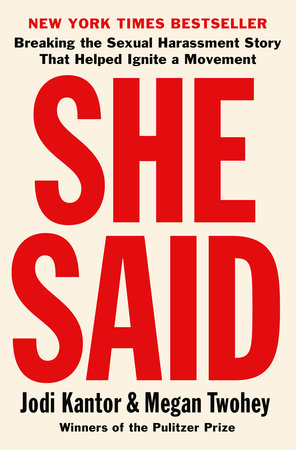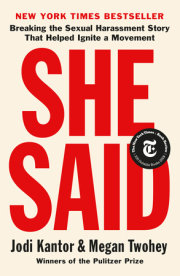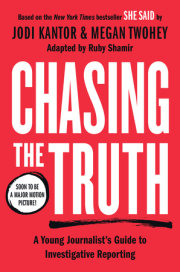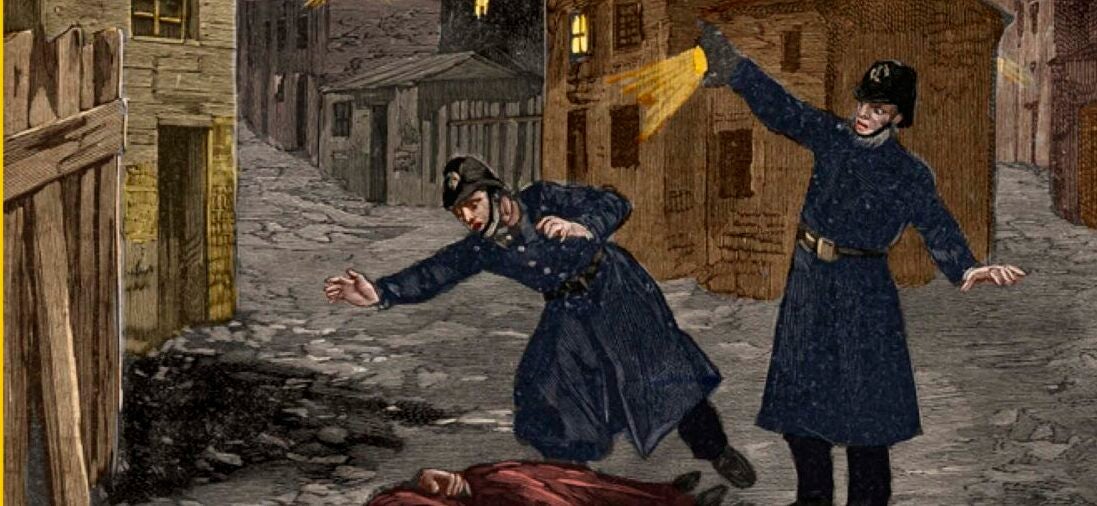Preface
In 2017, when we began our investigation of Harvey Weinstein for the New York Times, women held more power than ever before. The number of jobs once held almost exclusively by men—police officer, soldier, airline pilot—had narrowed almost to a vanishing point. Women led nations including Germany and the United Kingdom, and companies such as General Motors and PepsiCo. In one year of work, it was possible for a thirtysomething-year-old woman to make more money than all of her
female ancestors had made in their combined lifetimes.
But all too often, women were sexually harassed with impunity. Female scientists and waitresses, cheerleaders, executives, and factory workers had to smile past gropes, leers, or unwelcome advances to get the next tip, paycheck, or raise. Sexual harassment was against the law—but it was also routine in some jobs. Women who spoke up were frequently dismissed or denigrated. Victims were often hidden and isolated from one another. Their best option, many people agreed, was to accept money as some form of reparation, in exchange for silence.
The perpetrators, meanwhile, frequently sailed to ever-higher levels of success and praise. Harassers were often accepted, or even cheered, as mis- chievous bad boys. Serious consequences were rare. Megan wrote some of the original articles in which women alleged that Donald J. Trump preyed on them—and then she covered his triumph in the 2016 election.
After we broke the story of Weinstein’s alleged sexual harassment and abuse on October 5, 2017, we watched with astonishment as a dam wall broke. Millions of women around the world told their own stories of mistreatment. Large numbers of men suddenly had to answer for their predatory behavior, a moment of accountability without precedent. Journalism had helped inspire a paradigm shift. Our work was only one driver of that change, which had been building for years, thanks to the efforts of pio- neering feminists and legal scholars; Anita Hill; Tarana Burke, the activist who founded the #MeToo movement; and many others, including our fellow journalists.
But seeing our own hard-won investigative discoveries help realign attitudes left us asking, Why this story? As one of our editors pointed out, Harvey Weinstein wasn’t even that famous. In a world in which so much feels stuck, how does this sort of seismic social change occur?
We embarked on this book to answer those questions. Nothing about the change was inevitable or foretold. In these pages, we describe the motivations and wrenching, risky decisions of the first brave sources to break the silence surrounding Weinstein. Laura Madden, a former assistant to Weinstein and a stay-at-home mother in Wales, spoke out just as she was reeling from divorce and about to undergo post-cancer breast surgery. Ashley Judd put her career on the line, spurred by a little-known period in her life when she stepped away from Hollywood to immerse herself in big-picture thinking about gender equality. Zelda Perkins, a London producer whose complaints against Weinstein had been sup- pressed by an agreement she had signed two decades before, spoke to us despite potential legal and financial retribution. A longtime Weinstein employee, increasingly troubled by what he knew, played a key, and previ- ously undisclosed, role in helping us to finally unmask his boss. We intend the title, She Said, as a complicated one: We write about those who did speak out, along with other women who chose not to, and the nuances of how and when and why.
This is also a story about investigative journalism, beginning with the first uncertain days of our reporting, when we knew very little and almost no one would speak to us. We describe how we coaxed out secrets, pinned down information, and pursued the truth about a powerful man even as he used underhanded tactics to try to sabotage our work. We have also, for the first time, reconstructed our final showdown with the producer—his last stand—in the offices of the New York Times right before publication, as he realized he was cornered.
Our Weinstein reporting took place at a time of accusations of “fake news,” as the very notion of a national consensus on truth seemed to be fracturing. But the impact of the Weinstein revelations was so great in part because we and other journalists were able to establish a clear and over- whelming body of evidence of wrongdoing. In these pages, we explain how we have documented a pattern of behavior based on first-person accounts, financial and legal records, company memos, and other revealing materi- als. In the wake of our work, there was little public debate about what Weinstein had done to women; it was about what should be done in response. But Weinstein has continued to deny all allegations of non- consensual sex, and has repeatedly asserted that our reporting is incorrect. “What you have here are allegations and accusations, but you do not have absolute facts,” a spokesman said when we asked for a response to the rev- elations presented here.
This book toggles between what we learned during the course of our original work on Weinstein in 2017 and the substantial amount of information we’ve gathered since. Much of the new reporting we present about Weinstein helps illustrate how the legal system and corporate culture has served to silence victims and still inhibits change. Businesses are co-opted into protecting predators. Some advocates for women profit from a settle- ment system that covers up misdeeds. Many people who glimpse the problem—like Bob Weinstein, Harvey’s brother and business partner, who granted extensive interviews for this book—do little to try and stop it.
As we write this, in May 2019, Weinstein awaits a criminal trial for al- leged rape and other sexual abuse and faces a volley of civil suits, in which actresses, former employees, and others are seeking to hold him financially accountable. No matter the outcome of those cases, we hope this book will serve as a lasting record of Weinstein’s legacy: his exploitation of the work- place to manipulate, pressure, and terrorize women.
In the months after we broke the Weinstein story, as the #MeToo movement exploded, so did new debates about topics ranging from date rape to child sexual abuse to gender discrimination and even to awkward encoun- ters at parties. This made the public conversation feel rich and searching, but also confusing: Were the goals to eliminate sexual harassment, reform the criminal justice system, smash the patriarchy, or flirt without giving offense? Had the reckoning gone too far, with innocent men tarnished with less-than-convincing proof, or not far enough, with a frustrating lack of systemic change?
Nearly a year to the day after our Weinstein story was published, Dr. Christine Blasey Ford, a psychology professor from California, appeared before a U.S. Senate committee and accused Judge Brett Kavanaugh, then nominated to the Supreme Court, of sexually assaulting her while drunk in high school. He furiously denied the allegation. Some saw Ford as the ultimate hero of the #MeToo movement. Others saw her as a symbol of overreach—a living justification for the mounting backlash.
We saw her as the protagonist of one of the most complex and revealing “she said” stories yet, especially once we began to learn how much about her path to that Senate testimony was not publicly understood. Jodi watched from the hearing room, observed some of her legal team as they worked, and met her the next morning. In December, Megan conducted the first post-hearing interview of Ford, over a breakfast in Palo Alto. In the following months, she had dozens of hours of additional interviews with Ford about how she came to raise her voice and what the consequences were. We also spoke with others who shaped and witnessed her experience. We tell the story of Ford’s journey to Washington and how an overwhelming array of viewpoints, institutions, political forces, and fears all came to bear on her.
Many people wonder how Ford has fared since her testimony. The final chapter of this book consists of a unique group interview, in which we brought together some of the women we reported on, including Ford, across these different stories. But something larger is at stake in Ford’s odyssey too: that continued question of what drives and impedes progress. The #MeToo movement is an example of social change in our time but is also a test of it: In this fractured environment, will all of us be able to forge a new set of mutually fair rules and protections?
This book recounts two astounding years in the life of women in the United States and beyond. That history belongs to all of us who lived it: Unlike some journalistic investigations that deal with locked-away government or corporate secrets, this one is about experiences many of us recognize from our own lives, workplaces, families, and schools. But we wrote this book to bring you as close as we could to ground zero.
To relate those events as directly and authentically as possible, we have incorporated transcripts of interviews, emails, and other primary docu- ments. There are notes from the first conversations we had with movie stars about Weinstein, a searching letter that Bob Weinstein wrote to his brother, excerpts from Ford’s texts, and many other firsthand materials. Some of what we share was originally off the record, but through additional reporting, including returning to the parties involved, we were able to include it here. We were able to depict conversations and events that we did not witness firsthand through records and interviews. All told, this book is based on three years of reporting and hundreds of interviews conducted from London to Palo Alto; the endnotes give a detailed accounting of which information we learned from which sources and records.
Finally, this book is a chronicle of the partnership we developed as we worked to understand these events. To avoid confusion, we write about ourselves in the third person. (In a first-person account of our reporting, which was collaborative but often involved us following separate threads, “I” could be either Jodi or Megan.) So before we slip into that way of telling the story, we want to say, in our own voices: Thank you for joining our partnership for the duration of these pages, for puzzling through these events and clues as we have, for witnessing what we witnessed, and hearing what we heard.
Copyright © 2019 by Jodi Kantor. All rights reserved. No part of this excerpt may be reproduced or reprinted without permission in writing from the publisher.







